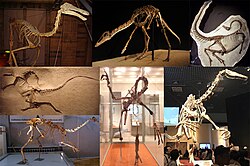
Back Ornithomimosauria Afrikaans عظائيات محاكية الطيور Arabic Ornitomimosaures Catalan Ornithomimosauria CEB Ornithomimosauria Czech Ornithomimosauria German Ορνιθομιμοσαύρια Greek Ornitomimosaŭroj Esperanto Ornithomimosauria Spanish Ornithomimosauria Basque
| Ornithomimosaurs Temporal range: Cretaceous,
| |
|---|---|

| |
| Collection of seven ornithomimosaurs, clockwise from top left: Gallimimus, Anserimimus, Ornithomimus, Deinocheirus, Harpymimus, Struthiomimus and "Gallimimus mongoliensis" | |
| Scientific classification | |
| Domain: | Eukaryota |
| Kingdom: | Animalia |
| Phylum: | Chordata |
| Clade: | Dinosauria |
| Clade: | Saurischia |
| Clade: | Theropoda |
| Clade: | Maniraptoriformes |
| Clade: | †Ornithomimosauria Barsbold, 1976 |
| Subgroups[9] | |
| |
| Synonyms | |
| |
Ornithomimosauria ("bird-mimic lizards") are theropod dinosaurs which bore a superficial resemblance to the modern-day ostrich. They were fast, omnivorous or herbivorous dinosaurs from the Cretaceous Period of Laurasia (now Asia, Europe and North America), as well as possibly Africa.[10][5] The group first appeared in the Early Cretaceous and persisted until the Late Cretaceous. Primitive members of the group include Nqwebasaurus, Pelecanimimus, Shenzhousaurus, Hexing and Deinocheirus, the arms of which reached 2.4 m (8 feet) in length. More advanced species, members of the family Ornithomimidae, include Gallimimus, Struthiomimus, and Ornithomimus. Some paleontologists, like Paul Sereno, consider the enigmatic alvarezsaurids to be close relatives of the ornithomimosaurs and place them together in the superfamily Ornithomimoidea (see classification below).
- ^ a b Holtz, Thomas R. Jr. (2012) Dinosaurs: The Most Complete, Up-to-Date Encyclopedia for Dinosaur Lovers of All Ages, Winter 2011 Appendix.
- ^ Hattori, Soki; Shibata, Masateru; Kawabe, Soichiro; Imai, Takuya; Nishi, Hiroshi; Azuma, Yoichi (2023-09-07). "New theropod dinosaur from the Lower Cretaceous of Japan provides critical implications for the early evolution of ornithomimosaurs". Scientific Reports. 13 (1): 13842. Bibcode:2023NatSR..1313842H. doi:10.1038/s41598-023-40804-3. ISSN 2045-2322. PMC 10484975. PMID 37679444.
- ^ Brownstein CD. (2016) Redescription of Arundel formation Ornithomimosaur material and a reinterpretation of Nedcolbertia justinhofmanni as an "Ostrich Dinosaur": Biogeographic implications. PeerJ Preprints 4:e2308v1 https://doi.org/10.7287/peerj.preprints.2308v1
- ^ Choiniere, J. N.; Forster, C. A.; De Klerk, W. J. (2012). "New information on Nqwebasaurus thwazi, a coelurosaurian theropod from the Early Cretaceous (Hauteriverian?) Kirkwood Formation in South Africa". Journal of African Earth Sciences. 71–72: 1–17. Bibcode:2012JAfES..71....1C. doi:10.1016/j.jafrearsci.2012.05.005.
- ^ a b Cerroni, M.A.; Agnolin, F.L.; Brissón Egli, F.; Novas, F.E. (2019). "The phylogenetic position of Afromimus tenerensis Sereno, 2017 and its paleobiogeographical implications". Journal of African Earth Sciences. 159: 103572. Bibcode:2019JAfES.15903572C. doi:10.1016/j.jafrearsci.2019.103572. S2CID 201352476.
- ^ Cuesta E, Vidal D, Ortega F, Shibata M, Sanz JL (2021). "Pelecanimimus (Theropoda: Ornithomimosauria) postcranial anatomy and the evolution of the specialized manus in Ornithomimosaurs and sternum in maniraptoriforms". Zoological Journal of the Linnean Society. 194 (2): 553–591. doi:10.1093/zoolinnean/zlab013.
- ^ Sereno, P. (2017). "Early Cretaceous ornithomimosaurs (Dinosauria: Coelurosauria) from Africa". Ameghiniana. 54 (5): 576–616. doi:10.5710/AMGH.23.10.2017.3155. S2CID 134718338.
- ^ Jin Liyong, Chen Jun & Pascal Godefroit (2012). "A New Basal Ornithomimosaur (Dinosauria: Theropoda) from the Early Cretaceous Yixian Formation, Northeast China". In Godefroit, P. (ed.). Bernissart Dinosaurs and Early Cretaceous Terrestrial Ecosystems. Indiana University Press. pp. 467–487. Bibcode:2012bdec.book.....G.
- ^ Cite error: The named reference
leeetal2014was invoked but never defined (see the help page). - ^ Choiniere, Jonah N.; Forster, Catherine A.; De Klerk, William J. (2012). "New information on Nqwebasaurus thwazi, a coelurosaurian theropod from the Early Cretaceous Kirkwood Formation in South Africa". Journal of African Earth Sciences. 71–72: 1–17. Bibcode:2012JAfES..71....1C. doi:10.1016/j.jafrearsci.2012.05.005.